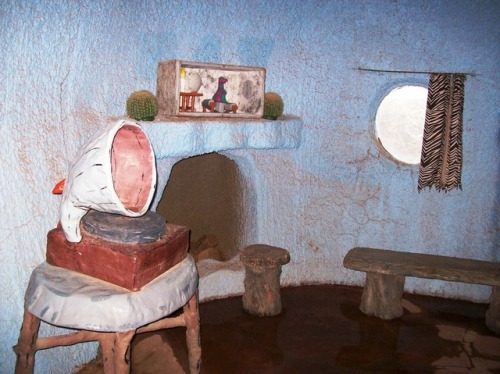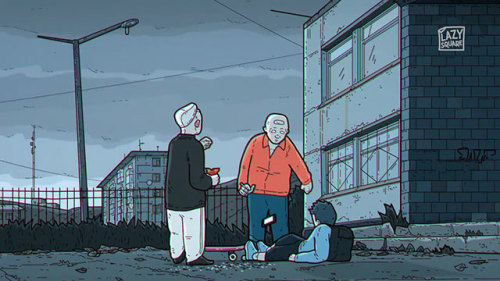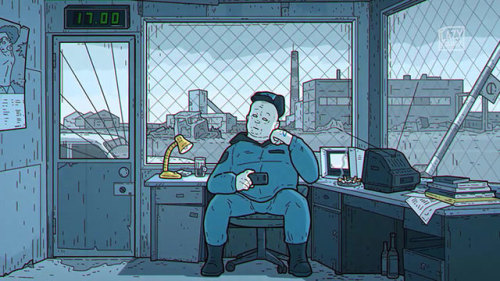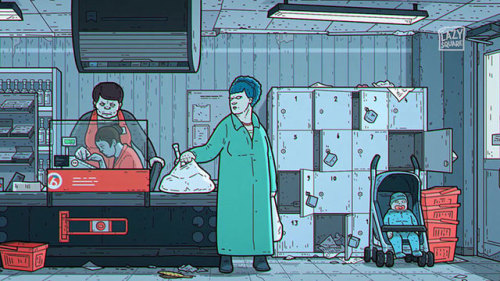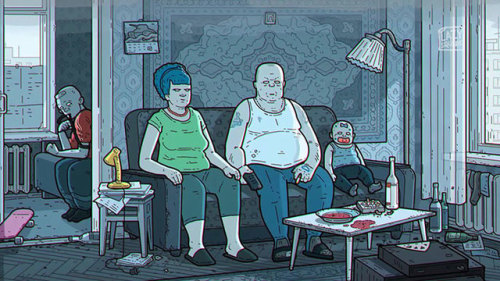

You probably associate getting older with a loss of energy. And on the molecular level, this is quite literally true.
One of the hallmarks of aging is mitochondrial dysfunction. Mitochondria are often referred to as “the powerhouse of the cell,” because they convert nutrients from the food we eat into usable energy, in the form of ATP. But as we age, mitochondria become less effective at generating the energy we need for various chemical processes.
So why does this happen? As with most things in biology, there are definitely multiple factors at work here. But one likely reason is a failure of quality control.
Mitochondria are dynamic structures. They engage in repeated cycles of fission and fusion, not unlike bacteria. Both of these processes are essential, but they need to be kept in balance. And therein lies the trouble. As we age, mitochondrial fusion tends to predominate, and fission is diminished. This eventually leads to the accumulation of gigantic, broken mitochondria that can’t work effectively, but are too large to be recycled through mitochondrial autophagy (aka mitophagy).
As you can imagine, the detrimental effects of mitochondrial dysfunction become most obvious in tissues that gobble up lots of energy, such as the brain and skeletal muscle. Hence, poor mitochondrial function is linked to poor muscular strength and slow gait in elderly individuals (see our past interview with the brilliant Keith Baar for more on this topic).
If only we could find a way to increase mitochondrial fission – and thus ramp up mitophagy – perhaps we could retain robust mitochondrial function throughout our golden years. But how?
That brings us to our guest.
GUEST
In this episode of humanOS Radio, we welcome Dr. Davide D’Amico to the show. Davide is a research scientist in the field of metabolism and aging. He was previously a post-doc at the Auwerx Laboratory of Integrative Systems Physiology at the École Polytechnique Fédérale de Lausanne (EPFL), where he investigated the role of mitochondrial function in health, disease, and the aging process.
Much of the discussion in this interview revolves around a recently published study from his team, which examined one of the molecular mechanisms through which defective mitochondria accumulate in cells.
Let me go ahead and quickly review what they did in this study, and their findings.
STUDY
In this experiment, Davide and his colleagues at the Auwerx Lab focused their attention on RNA-binding proteins – small molecules that bind mRNA molecules, and in doing so can regulate the fate or function of the bound RNA after transcription.
The researchers screened cells from elderly animals, hoping to identify RNA-binding proteins that are altered by the aging process. Their search revealed Pumilio2 (PUM2), which was shown to be highly  expressed in older animals.
expressed in older animals.
Okay, so what exactly does this protein do? To figure that out, we need to know its binding sites. The scientists then looked for the mRNA targets of PUM2. They found that PUM2 binds an mRNA which encodes for a protein known as Mitochondrial Fission Factor (MFF). As the name indicates, MFF regulates mitochondrial fission. Higher levels of MFF increases division of mitochondria into multiple smaller organelles, and importantly facilitates the removal of dysfunctional mitochondria through mitophagy.
When PUM2 binds to its target, it inhibits the translation of MFF. In other words, more PUM2 should mean less MFF. The researchers confirmed that this was indeed the case when they analyzed the muscles and brain tissue of old animals. Sure enough, the tissue samples contained abundant amounts of PUM2, and correspondingly less MFF proteins. As you would expect, reduction in MFF in these aging animals was accompanied by less mitophagy, and poorer quality mitochondria. No bueno.
'What was more interesting is that these worms with better mitochondria...were healthier. They were moving more. They were moving faster. Ultimately, they were living longer.'
Click To Tweet
So you might be thinking now that interfering with PUM2 could be the key to reversing this unfortunate trend. If so, you’ve got the right idea. And that brings us to the really cool part of the study. The researchers then used CRISPR-Cas9 to selectively inactivate the gene that encodes for PUM2 in skeletal muscle of older animals. By depleting this gene, they were able to augment the translation of MFF, and in turn increase mitophagy. This resulted in improved mitochondrial function and increased lifespan in these animals.
TRANSLATION
There is presently no known way to repress PUM2 activity in humans. But luckily, there are other methods through which we might be able to enhance mitochondrial autophagy.
Davide is currently working as a scientific project manager at Amazentis, where he is investigating naturally derived bioactives that could reverse age-related muscle decline by modulating mitochondrial function.
Amazentis’ lead bioactive is urolithin A, which has been shown to induce mitophagy in model organisms. Urolithin A is a metabolite that results from the biotransformation of dietary ellagitannins via the gut microbiota. Ellagic acid and ellagitannins are found abundantly in foods we eat, most  notably in pomegranate, walnuts, and berries. However, individuals vary in the extent to which they can convert these phenolic compounds into urolithin A. So if you don’t have the right mix of gut microbes, you could eat all of the pomegranate in the world, and potentially still fail to generate this metabolite. This means that one may need to supplement the compound directly, in order to fully reap the benefits. And of course, we’ve been unable to determine whether this works in humans…until now.
notably in pomegranate, walnuts, and berries. However, individuals vary in the extent to which they can convert these phenolic compounds into urolithin A. So if you don’t have the right mix of gut microbes, you could eat all of the pomegranate in the world, and potentially still fail to generate this metabolite. This means that one may need to supplement the compound directly, in order to fully reap the benefits. And of course, we’ve been unable to determine whether this works in humans…until now.
Just last month, Amazentis published the first human clinical trial results on urolithin A, demonstrating that regular oral administration in healthy elderly subjects was safe and effective in improving mitochondrial health, by upregulating mitochondrial gene expression in skeletal muscle. To put this into perspective, realize that there are basically no effective treatments for age-related decline in muscle function (other than exercise, of course). So this is a truly promising finding, and one that could benefit every single one of us someday.
To learn more about Davide’s study, and his exciting work, please check out the interview below!
LISTEN HERE
On Soundcloud, iTunes, Google Play, Stitcher, and YouTube
YOUTUBE
SUPPORT
Have you considered becoming a Pro member of humanOS.me? It costs just $9.99 per month, and when you go Pro, you get access to all our courses, tools, recipes, and workouts. Pro members also support our work on blogs and podcasts, so thanks!
LEAVE A REVIEW
If you think other people would benefit from listening to this show, you can help us spread the word by leaving a review at iTunes. Positive reviews really help raise the profile of our show.
TRANSCRIPT
| Davide D’Amico: | 00:06 | We have better mitochondria. They respired. They produced more energy and what was more interesting is that these worms with better mitochondria, they were healthier. They were moving more. They were moving faster. Ultimately, they were living longer. |
| Kendall Kendrick: | humanOS. Learn. Master. Achieve. | |
| Dan Pardi: | 00:19 | Welcome back, everyone. Today, I have with me Dr. Davide D’Amico. Davide, welcome to the show. Tell us about where you work and the type of work that you do and when you became interested in the aging field. |
| Davide D’Amico: | Hi Dan. First of all, thank you very much for inviting me here today. It’s a great pleasure. I’m a research scientist in the field of metabolism and aging. As you said, I got interested in the field of aging and in particular mitochondrial biology. | |
| 00:33 | If you ask me why I got interested in aging. That’s the main reason why is that we are all in the process of aging. To me it’s quite exciting to understand what is happening in our body and getting more in detail, in our tissues and in our cells when we age. Understanding this mechanism can lead to new strategies to slow down the aging process. | |
| The second reason is that with deeper understanding of aging, it is very important to understand other aging-related diseases. I’m talking about neurodegenerative disorders and similars. | ||
| Dan Pardi: | 00:46 | Tell us about the company that you’re working for at the moment. |
| Davide D’Amico: | I’m working with the Swiss-based biotech start-up. It’s called Amazentis. Amazentis is working on advanced, innovative nutritional strategies. The goal is to improve cellular health using compounds derived from natural products. I would say this is a nice [inaudible 00:01:55] did in my previous studies as a PhD, as a post [inaudible 00:02:00], as a scientist. I would say that the goal after many years in the lab was to apply my scientific expertise in something that was more translated and more applied in a product that could be useful to improve the health of people. | |
| Dan Pardi: | Mitochondria are unquestionably one of the areas that I am most interested in. Why don’t we lay a little groundwork here. Talk about mitochondria and how they regulate cellular health, how cells will build mitochondria and how cells will exercise quality control when certain mitochondria within the cells fail to function properly. | |
| Davide D’Amico: | Yes. The mitochondria are essential organelles in our cells. Basically, all kind of cells contain mitochondria except the red blood cells. We can consider the mitochondria as powerhouse of our cells. They’re really the hub where most of the energy is produced to make our cell work properly. The mitochondria has a long list of other function, regulating the cell proliferation and survival, inflammation and stress and so on. The cells are taking a lot of care to keep our mitochondria healthy and well-functioning. We are constantly building up new mitochondria in a process that is called mitochondrial biogenesis. This new mitochondria, they get interconnected into networks. They’re really 3D networks inside our cells. If you see that picture there, they are extremely beautiful to perceive. | |
| 01:34 | In this network is where all this energy production happens. Mitochondria is a bit like our self or our own body where the time get older or they can get stressed, they start to function less. There might be some reduced mitochondria. In this case, the mitochondria are constantly checking the status of the mitochondria. They are fixing them or when this is not possible, they have specific mechanism to remove dysfunctional mitochondria. This last process is extremely important, it’s called mitophagy. This word comes from Greek. It means literally “eating mitochondria”. Mitochondria are isolating and removing the bad mitochondria and keeping the healthy one. | |
| You are asking me what happens when this quality control system don’t work properly. The answer is quite logical. Since mitochondria are essential, if we start having issue with mitochondrial function, this affects the whole cellular and organismal health. It’s really hard for me to tell one disease or one problem that is not caused or connected with mitochondrial dysfunction. | ||
| Dan Pardi: | 01:38 | Thanks for that introduction. We tend to think of mitochondria as the powerhouse of the cell which is true. There is hundreds to thousands in cells except for red blood cells. They are not only producing energy from the food that we eat, the air that we breathe to make energy that the cells use, but they are involved in other types of functions as well that keep the cells functioning in other ways aside from just energy production. They will go through this process where they fuse together and then they undergo fission where they then pull apart. That’s constantly happening in the background to support energy that the cell needs for all of its functions. |
| I read a bit ago from fightaging.org that every single mechanism of aging that we know of is connected to mitochondria in some way. That really thrust the importance of it to me. What happens to mitochondria as we age? What are some of the issues that occur during the aging process? | ||
| Davide D’Amico: | 02:15 | Yeah. You introduced a true concept that I skipped in the previous question which is mitochondrial fission and fusion. Truth about these networks and mitochondria are organized in networks which are dynamic. They got fused and they got fragmented in smaller mitochondria. It can produce new mitochondria. |
| Mitochondrial dynamics is extremely important to keep the mitochondria healthy. Upon aging, what happens is that this whole mitochondrial dynamic process is not functioning properly. One thing that happens is that the old mitochondria are not replaced by new one. They start to accumulate as dysfunctional organelles. In healthy cells, you have some well-organized networks. Upon aging, these mitochondria inside the network, they become thicker and bigger and more dysfunctional. When the mitochondria become bigger, one problem is that the cells are not able to remove them. This is a vicious cycle. The more we age, the more we accumulate these mitochondria. If we are not able to induce a mitophagy then the mitochondrial mass and dysfunction will grow more and more. | ||
| Dan Pardi: | 02:33 | The larger they get … Does that mean then it’s harder to degrade them? |
| Davide D’Amico: | It’s really a physical issue. The cell is usually cutting this network into small pieces, isolating the bad mitochondria out of this network and then is taking out this smaller bad mitochondria, putting around them an envelope, let’s say. And then, targeting them to specific machinery to degrade them. If these mitochondria are too big, then you can physically not isolate and remove them. In this sense, fragment this bigger mitochondria is an essential step to isolate the bad mitochondria and remove them through mitophagy. | |
| Dan Pardi: | In the more recent study, you examined the role of RNA-binding proteins in the aging process. What are RNA-binding proteins? | |
| Davide D’Amico: | RNA-binding proteins as the name says are the class of proteins that are binding RNA. What is RNA? RNA, it’s a molecule that is containing our genetic information from the DNA and is used to produce proteins. The information in our cells goes from the DNA, it’s our genome, then this information is passed to RNA and then from RNA to protein. When we go from RNA to proteins, here we have the RNA-binding proteins. RNA-binding proteins are essential to transmit the information from RNA to proteins. | |
| 04:32 | One mechanism is called protein translation. The information in RNA is translated into another class of molecules called proteins. Proteins are the molecules that are doing a lot of essential things in our cell. They are one of the most important building block of our cells. | |
| Dan Pardi: | I see. What happens when RNA-binding proteins function abnormally? What impact does that have in the body and in the disease process? | |
| Davide D’Amico: | Well, we have three effects. As I said, RNA-binding proteins are essential to translate RNA into proteins. When they are dysfunctional, these causes abnormal protein translation. Depending on the protein, if the protein is essential for our cellular function, the effect is reduced cellular health. Another effect is that a feature of RNA-binding proteins is that they tend to aggregate, to stick one to each other and form bigger protein complexes. This is something that happens normally in our cells but it’s a very dynamic process. We have these aggregates. Then they are rapidly removed. But in aging and in some disease condition, these RNA-binding proteins, they stay stably in these aggregates and they have some toxic functions. There are a lot of examples of diseases and aging as well where RNA-binding proteins don’t work properly. They aggregate and then they have detrimental effects on translation and cellular function. | |
| Dan Pardi: | 05:22 | You were looking at RNA-binding proteins that are altered in the aging process in muscle and in the brain of animal tissues. Describe what your team did and are there any particular reasons why you chose to focus on muscle and the brain specifically. |
| Davide D’Amico: | The reason is that RNA-binding proteins are linked to many diseases. Alzheimer and Parkinson are linked to it, abnormal RNA-binding protein function. ALS is another notable example. Most of these diseases are connected with neuronal tissue and muscle tissue. It’s clear that muscle and brain are a tissue where RNA-binding proteins have a clear role. It was quite obvious to check these tissues in the context of aging. What was interesting is that it’s well known that mitochondrial function is declined upon aging but it was not very clear the role of RNA-binding proteins in the context of aging. | |
| What we did is to use a number of aging studies that were done in the past. Some studies where people were analyzing young animals and comparing them to old animals or young versus old individuals, so humans. Then, they were checking which kind of molecules were changed. I saw that only the RNA-binding proteins that were changed upon aging. I crossed all the studies to make the analysis stronger. I ended up with a short list of candidates that were RNA-binding proteins modulated upon aging. One was significantly changed in all the studies, this RNA-binding protein called PUM-2, P-U-M-2. The long name is Pumilio2. In particular, in all these aging study, PUM-2 was induced upon aging in muscle and brain tissue. The more we age, the more PUM-2 we have in the tissue. This was the first finding. The question that came out spontaneously was why? Clear that we have more PUM-2 but what is the role of this high level of PUM-2 when we age? This was very exciting question. The results pointed out to mitochondria again. Here we link back to mitochondria that we discussed in the beginning with RNA-binding proteins. | ||
| Dan Pardi: | 06:30 | So Pumilio … Does it rise linearly across the lifespan or is there a period where all of a sudden, its aggregation starts to increase? Is that happening at a certain time in a lifespan? |
| Davide D’Amico: | This we couldn’t really do. Most aging studies that we analyzed were really heterogeneous. We were doing a really simple comparison of young versus old and we were doing it in different species. We were using mice, humans, worms called C. elegans. They are nematodes. They are a very nice model organism for aging. They are all different in terms of age of course. In mice, we checked animals that were around 20 month old which correspond to 60-65 years in humans. We didn’t do a linear analysis. We don’t know when this starts. | |
| Dan Pardi: | 06:34 | … because we know that this protein in higher in older organisms across all species whether it’s mice, humans or nematodes. |
| Davide D’Amico: | Yes. That’s correct. | |
| Dan Pardi: | 07:10 | How exactly does PUM-2 affect mitochondrial function? |
| Davide D’Amico: | Good question. We used approach that is called the multi-omics. Basically, we analyzed a lot of different effects of PUM-2 on our RNA, on our proteins, on our metabolism. The goal was to see which was the specific target of PUM-2. I don’t go into details but I [inaudible 00:13:01] multi-omic analysis, we identified one specific target that is called MFF. This stands for mitochondrial fission factor. | |
| 07:20 | We were talking about mitochondrial fission in the beginning of our discussion. This is a key component of the mitochondrial dynamic process. In particular, mitochondrial fission is the process by which a mitochondrial network is fragmented into smaller mitochondria. We already said that this is a key step to allow the cell to sort the bad mitochondria and remove them through mitophagy. This was actually cool because we linked a RNA-binding protein in aging with mitochondrial function which is a well-known hallmark of aging. | |
| Dan Pardi: | You mentioned earlier that older mitochondria form these large networks and they can’t divide and then clear them out through mitophagy. What is the relationship then with PUM-2 and this mitochondrial fission factor? Does PUM-2 suppress that therefore inhibiting the process of fusion in mitochondria? | |
| Davide D’Amico: | Exactly. Going more into the mechanism. What is happening is that, in old tissue, there is an accumulation of Pumilio2. Pumilio2 is an RNA-binding protein and is binding the mRNA of MFF, a mitochondrial fission factor. The binding of PUM-2 to MFF is repressive. PUM-2 is blocking the translation of MFF mRNA. We have less MFF with more PUM-2. The consequence is to have more PUM-2, to have less MFF, and as a consequence, reduced mitochondrial fission. This mitochondrial fission is essential for mitophagy. The very final consequence is that PUM-2 is reducing also mitophagy. This is extremely important in the context of aging. | |
| Dan Pardi: | 08:16 | What happens if you somehow can affect PUM-2 or MFF directly? Would that increase mitophagy and then have an effect on health span? I know that you took a look at that in the nematode. What happened when you depleted the PUM-2 ortholog in that animal models? |
| Davide D’Amico: | If we have PUM-2, we have less mitophagy. Our expectation was that removing PUM-2 would have led to increased mitochondrial fission and mitophagy. Then this was the case. We used the nematode first because it was a simple model to work. We did some revolutionary analysis to see which was the worm protein that corresponded to PUM-2. This was called PUF-8. We removed PUF-8 from the worms and we saw a number of things. We checked first of all the mitochondria. In the old worms, they have this big dysfunctional mitochondria. When we removed PUF-8, this big mitochondria become smaller and the network was much better organized and similar to the young worms. We really reverted the age-associated phenotype. We have better mitochondria. The mitochondria, they respire. They produce more energy. What was more interesting was that these worms with better mitochondria, they were healthier. They were moving more. They were moving faster. Ultimately, they were living longer. | |
| Dan Pardi: | 08:24 | Moving from the nematode model into the murine model, what did you do there to reduce the activity of PUM-2? |
| Davide D’Amico: | When we removed PUM-2 from the muscle of old mice, we used a different strategy to achieve this. We used the CRISPR-Cas9 technology. It’s relatively reasonable but it’s not a promising and extremely exciting science behind this technique. Basically, these are genomic molecular scissors. We have these proteins that are able to recognize very specific regions of our DNA and then modify and remove them. What we did is to use this CRISP scissor to target the gene encoding for PUM-2. CRISP was cutting the PUM-2 gene. In this way, we ended up with muscles without PUM-2. | |
| Dan Pardi: | 09:27 | What were some of the effects that you saw after being able to successfully crop out PUM-2? |
| Davide D’Amico: | From the muscle, we saw results that were consistent with what we observed in the nematodes. The old mice had in the beginning this giant dysfunctional mitochondria. After removing PUM-2, this mitochondrial network was again resembling networks from young animals. We had better mitochondrial networks, more mitochondrial fission, more mitophagy and ultimately, more mitochondrial function. The whole axis was conserved in C. elegans and in mice. | |
| Dan Pardi: | 09:39 | Were you able to then observe any behavioral changes in the older mice? Were they also moving more and moving faster? |
| Davide D’Amico: | This we couldn’t check because working with mice, it’s a bit more complex especially using CRISP. To make the whole system very efficient, we targeted CRISP only in one muscle so we could analyze the function of the one muscle. But this is an excellent question and would be a beautiful follow-up of this paper. To be able to remove PUM-2 from different muscle and see the effects of muscle function. | |
| Dan Pardi: | I could imagine if you see that work where we now have evidence to support cropping out PUM-2 with Cas9 that you’d see the mitochondrial networks appearing to be healthier and having enhanced respiration capabilities. If the next step then could be to do that in living mice and then do the older mice function well, that would certainly give way to early stage investigation in humans. | |
| Davide D’Amico: | 11:39 | In the humans, this would be great. I think that using CRISP to remove PUM-2 in aging is a bit hard I would say. CRISP is an extremely useful tool to remove and to correct very specific enzymatic disorder. I’m talking about mutates that can cause dystrophies or other diseases. Probably that’s a high hanging fruit. What is clear from this study is that the mechanism of mitochondrial dynamics and mitophagy is essential in aging. Even if we cannot target PUM-2 to improve mitophagy, we might find other strategies to get the same results which might be even more efficient. |
| Dan Pardi: | Obviously, taking care of mitochondria is really important for our health long term. Might there be pharmacological interventions or even nutraceutical interventions … we know anything that represses PUM-2 activity enhances MFF activity from a compound perspective? | |
| Davide D’Amico: | 11:51 | From a compound perspective, no. There are no compounds known to inhibit PUM-2, but the field of mitochondrial dynamics and especially mitophagy is growing in the last years. There are not many proven efficient way to improve mitophagy, mitochondrial functions in the market now but this is a very exciting field. I mentioned in the beginning that I am working with a start-up and this is exactly the field I’m working in. What we’re doing, it’s to find new strategies or the next generation nutraceutics to improve mitochondrial function and mitophagy or cellular health. This paper is showing a new mechanism. I think the future is now to find some compounds that are efficiently targeting to improve cellular health in aging and related conditions. |
| Dan Pardi: | You’re looking for compounds that might affect cellular health and muscular health and specifically looking at natural compounds that might do so? | |
| Davide D’Amico: | 12:29 | Exactly. We are looking for derivatives of natural compounds to improve cellular health. |
| Dan Pardi: | What do you think are some cutting-edge strategies that people could employ now to take care of their mitochondria today? | |
| Davide D’Amico: | 12:37 | There are two strategies that they can follow to improve mitochondrial function at the moment. One is exercise and one is nutrition. Exercise is one of the best way to improve our mitochondrial function. This is well studied and well known. The second one is nutrition which is also extremely important because we need to be extremely committed to exercise and to maintain our mitochondrial function. Talk about smart nutrition. Because sometimes it’s not enough what we are eating even if we consider it healthy, but we need to think that each of us needs to tailor our nutritional habits depending on our self, our genetic background, our microbiome, which is the pool of bacteria that are in our intestine. These are converting what we are eating in the active molecules. This is one of the exciting field of research I am following in Amazentis. |
| Dan Pardi: | That connection is so important, not always understood or appreciated. People might be doing those strategies now without even realizing it but if we do have greater understanding of it, we might be able to capitalize on it more effectively. | |
| Davide D’Amico: | 12:38 | It’s good to exercise. It’s good to have a healthy nutrition, but we need to really take care about what we are eating depending also on this other army just like the microbiome that we harbor. |
| Dan Pardi: | … and fasting too. If you can figure out how to accelerate mitophagy and that could induce it with a fasting regimen, could you amplify the benefits of a fast with the inclusion of certain natural compounds or techniques that makes mitophagy double or triple in that couple of day fast. That would be interesting too. | |
| Davide D’Amico: | 12:41 | Absolutely. |
| Dan Pardi: | Well, Davide. Thank you so much for coming on to talk about this extraordinarily interesting connection and the process by which you went down that path to identify this as a fruitful area for further investigation. I’m excited to keep an eye on your company and see what you guys come up with. I really appreciate your time today. | |
| Davide D’Amico: | Thank you very much, Dan. | |
| Kendall Kendrick: | 13:46 | Thanks for listening. Come visit us soon at humanOS.me. |
The post Increasing Mitochondrial Autophagy for Better Aging. Podcast with Davide D’Amico. appeared first on humanOS.me.
